“For the Sake of Martyrs Thrown into the Fire” – The Righteous Man who Risked His Life to Thousands of Transylvanian Refugees
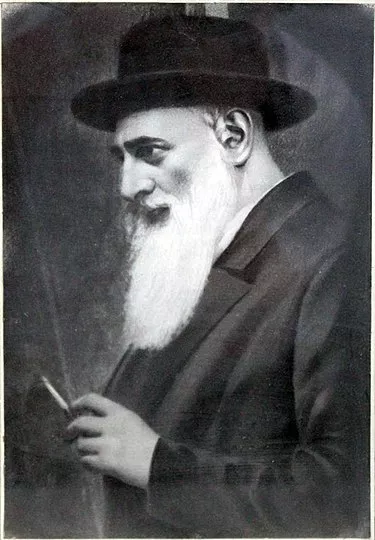
Elul 2 (Falling on Aug. 19th in 2023) marks the yahrzeit (anniversary of death) of the Vizhnitzer Rebbe, Rabbi Eliezer Hager z”l, known as the “Dameshek Eliezer,” after his book.
Seventy-seven years ago, the great and holy rabbi passed away after a fatal illness that took its toll on him, and he was only 55 years old..
Many hardships befell the Dameshek Eliezer of Vizhnitz, but he was often calm and peaceful, and “the joy of God was his fortress”.
Most of his days on earth were full of agony and rage, in which broken-hearted Jews required much encouragement and comfort. And if during all his days that were good, he would “give strength and power to the people”, then this was especially the case in the years of rage, during the days of the terrible Holocaust, tens of thousands of Jews were filled by the streams of faith that stemmed from his pure heart and good eyes.
In those days of evil, the Dameshek Elieser, put his life on the line by operating an amazing system of rescue which, according to testimonies, saved thousands of men, women, and children.
He did not only take care of rescueing the war refugees and finding them hiding places, but also, and above all, he cared for their livelihood and sustenance. He gave his whole heart and soul for the sake of the exiled and dying Jews. He could have easily obtained an immigration visa to the Land of Israel at the beginning of the war, but he never even thought of such an idea. In 5700 (1940) he escaped by the skin of his teeth from the city of Vizhnytsa (Vizhnitz) to Timisoara, from where he sent food shipments for the Jews who were exiled to the swamps of Transnistria and who were starving there. For this he sold all his possessions, including his wristwatch. [1]
Those who emigrated to the Land of Israel worked hard on behalf of the survivors and the rebirth of the glorious Vizhnitz chassidism and the holy yeshiva “Beit Yisrael and Dameshek Eliezer.”
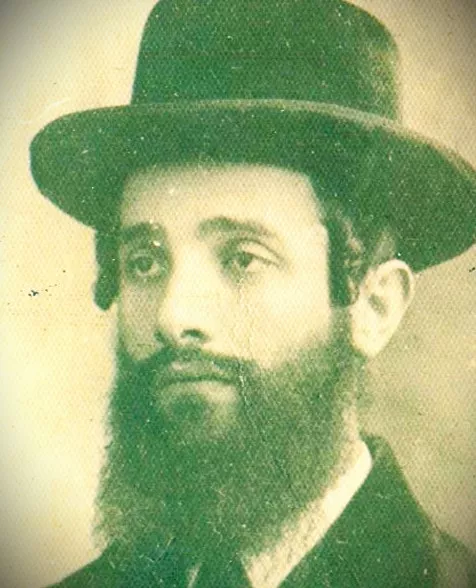
In 5651 (1891), he was born as the third son to his father, the holy Vizhnitzer Rebbe, the “Ahavat Yisrael” (Lover of Israel) and his mother, the righteous Rebbetzin Hinda, the daughter of Rabbi Meir Horowitz, the “Imrei Noam” of Dzikow. He was named after his mother’s grandfather, Rabbi Eliezer of Dzikow.
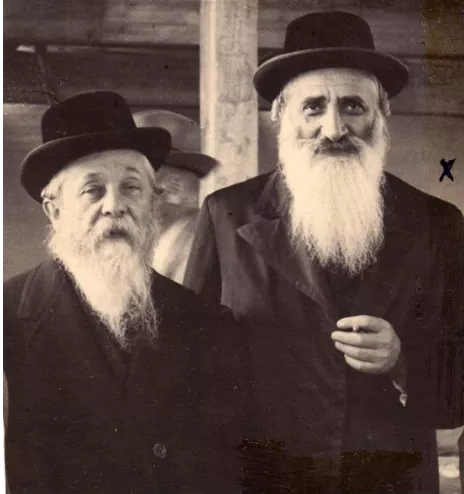
With his brother-in-law, the Kopishnitzer Rebbe
In the year 5667 (1907) he established his home with his rebbetzin, Chava, the daughter of Rabbi Yitzhak Meir Heshel of Kopishnitz. In the same time perod he was authorized to teach by the Maharasham of Berezhany (Rabbi Shalom Mordechai Schwadron) and Rabbi Shmuel Engel of Radomysl.
During the First World War, he lived in Vienna together with his father-in-law. During these years, he was in contact with many Torah giants who stayed in Vienna following the war, including Rabbi Avraham Menachem Steinberg (author of “Machazeh Avraham”), who also ordained him as a rabbi.
His father, the Ahavat Yisrael, loved him very much and spoke about him many times in a rare way, such as in this statement:
“When I go up to the yeshiva of ma’ala (when I pass away) and they ask me what I brought up in this world, it’s enough for me if I answer ‘I brought my Eliezer on earth’…”
And in the year 5682 (1922), when it became clear to the Jews of Bukovina that their rabbi, the Ahavat Yisrael, did not intend to return to Vizhnitz after settling in Groswardein, and they asked him to send them one of his sons to serve as the their rabbi, he ordered his third son, Rabbi Eliezer, to take on his burden. A new chapter began in the history of the city upon Rabbi Eliezer’s appointment to the rabbinate of Vizhnitz, in which 95% of the inhabitants were Jewish.
Like the son of a noble king, Rabbi Eliezer appeared in the city of Vizhnitz, and the Jews were fascinated by the personality of the young rabbi whose quiet and shy demeaner embodied strong powers.
He magically began to draw the hearts of the youth back to his following, and in 5683 (1923), he reestablished the great yeshiva in Vizhnitz, in which thousands of students burning with passion for the revered Rebbe passed through.
And there were days, days of confusion and downtroddenness. In Bukovina almost no Jews lived in those days with a chassidic image of “Erlicheh Yidden” (honourable Jews). Most of them did not return after the First World War, and the young people who did return, for the most part, sadly began to loosen their religion and followed various national movements. If not for Rabbi Eliezer and his yeshiva, there would hardly have been a single religious young man left in the whole area, and as the holy Rabbi Chaim Meir of Vizhnitz and Rabbi Baruch of Seret-Vizhnitz wrote in their preface to the book Dameshek Eliezer:
He (Rabbi Eliezer) established the level of Torah in the areas of Bukovina and Romania, where the Torah was almost forgotten after the First World War, and he made ears hear the Torah and had many hundreds of thousands of students who through him drew closer to their Father in Heaven, to the Torah, and to chasidism. And the foundation of the Torah was raised and the honour of the Torah was multiplied by him, because with all his heart and soul, he cared for the disciples, like a merciful father to his sons, and he repaid many wrongdoers with the sweetness of his lips. He was pleasant and holy in his ways.
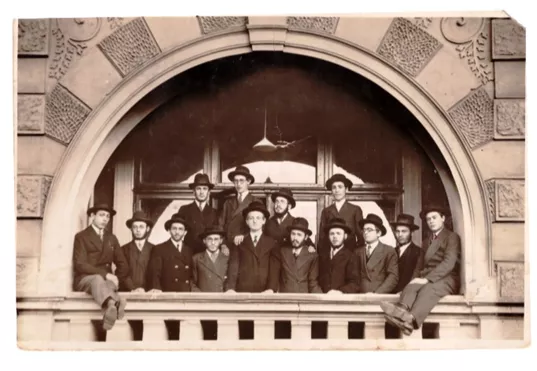
The yeshiva of the Dameshek Eliezer was housed in magnificent buildings because only in this way, he claimed, would there be a chance that the confused Jewish youth would return to the yeshiva’s benches. Thanks to his personal charm, he was able to raise huge sums for his purposes and thus, later, with the rise of the yeshiva, he founded a Bais Yaakov school for girls, through which he also saved countless souls of Jewish girls from assimilation.
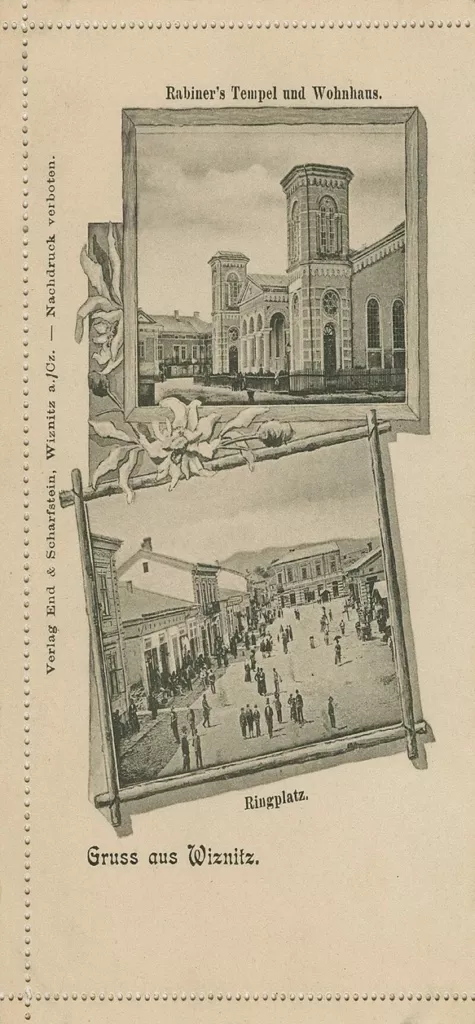
The Dameshek Eliezer encouraged many of his followers and students to immigrate to the Land of Israel, and these people became the pillar and cornerstone of the rebuilt Vizhnitzer chassidic community in the Land of Israel after the terrible Holocaust.
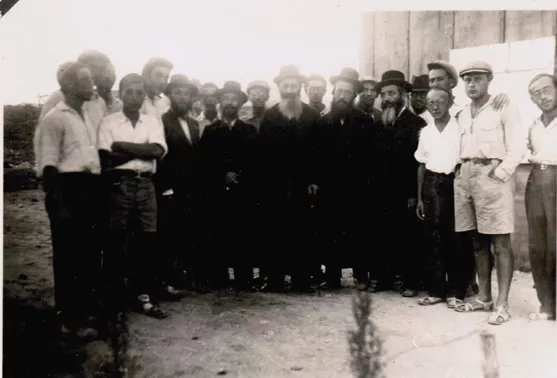
The Dameshek Eliezer with his brother in Kibbutz Chafetz Chaim, with students who immigrated to the Land of Israel before the Holocaust in order to make the wasteland blossom
The years between the two wars posed existential challenges to the Jewish communities in the entire area, and thanks to the leadership of Rabbi Eliezer, whom even antisemitic Gentiles adored, Jewish institutions and life ran smoothly. The Rebbe was on his feet and even traveled far and wide for dealings in high places, and his words would find traction in the hearts of government officials and policy makers. He was credited with the exceptional approvals granted for the Jewish institutions all over Bukovina and other districts throughout Romania.
When the Romanian government decreed that the Jews should open their shops on Shabbat, the Rebbe turned worlds over to get the decree cancelled and initiated a large rabbinic gathering in Czernowitz. He then traveled to Bucharest and stayed there for two weeks, all of his food at that time being bread and grapes, even though he had barely recovered from a severe lung disease that weakened his body . In the end, the Rebbe was indeed able to meet with the heads of government and get the decree cancelled, and the country quieted down.
The terrible war, which came to Romania in 5700 (1940), changed the “order of creation” and caused an unprecedented disaster on the Jewish communities that had been planted in the area for generations.
“The name Transnistria is an artificial geographical definition created during World War II, and refers to the part of Ukraine that Hitler gave to Romania in exchange for its participation in the war against the Soviet Union. Transnistria lies in western Ukraine, between the rivers Bug in the east and Dniester in the west, between the coast of the Black Sea in the south and between the northern line to the city of Mogilev. The meaning of the name Transnistria is ‘beyond the Dniester’ (in Romanian the river is called Nistru).”
“Transnistria was occupied by the Germans and Romanians in the summer of 1941. Before the war, there were about 300,000 Jews in the region. Tens of thousands of them were murdered by Einsatzgruppe D under the command of Otto Ohlendorf and by the German and Romanian armies. After its conquest, Transnistria was a place of concentration for the Jews of Serbia and Bukovina to which the Jews were deported by order of Ion Antonescu. The deportations began on September 15th, 1941 and continued intermittently until the fall of 1942. The survivors of the murders in Bessarabia and northern Bukovina were mostly deported to Transnistria and concentrated in ghettos and camps in northern and central Transnistria. The deported Jews were prohibited from freedom of movement and choosing their place of residence, and were subject to forced labor.” (Source: Yad Vashem)
The holy Vizhnitzer Rebbe, as mentioned, could have escaped, thanks to the vigorous efforts of his numerous and influential followers, but out of self-sacrifice, he chose to stay with the Jewish community who were in trouble and captivity, and was able to save many Jewish lives. On the day he received a certificate for Israel, he said: “I am not moving from here as long as I can save even one Jew from starvation.”
More than once, the Rebbe risked his life due to his actions performed both openly and in secret. He was forced to forge connections with German officers and bribe them with large sums of money for the purpose of freeing and rescuing Jews, whose number, according to those who wrote about what happened at the time, “reached thousands, both Torah and mitzvah observant and non-Torah and mitzvah observant”.
“With the power of his great influence to collect large sums of money to redeem Jewish captives from the German prisons, and with his royal appearance, he managed to win the hearts of the good people of the gentiles in Bukovina who gave shelter and hiding places to oppressed and persecuted Jews, and even donated funds to save Jews from extermination.”
“He did not consider his mission finished until he rescued the redeemed Jews from danger…”
(By Leib Bein, writer of the “Morgen Journal”, who was close to the Rebbe and even had a conversation with him, a wonderful conversation that was published in his newspaper)
Many of the refugees from Romania and Ukraine whose lives were saved due to the Rebbe’s actions have written down their memories, and they are some of the most famous. He will be remembered for good by his faithful servant, a man in whom there is a spirit, the glorious Rabbi Ben Zion Shechter son of Rabbi Shaul, may G-d avenge his blood, who, had a part in the success of the rescue operations of the Rebbe. Rabbi Ben Zion, “our right hand and faithful helper in his holy work , especially in the great rescue operations on behalf of the refugees in Transnistria, who worked with unimaginable self-sacrifice and tirelessly at the very risk of their lives, perished at the hand of the Nazis in the Mefkure ship disaster on its way to the Holy Land on the 17th of Menachem Av 5704 (Aug. 5, 1944), may G-d avenge their blood.” (Quote from the introduction to the Damascus Eliezer edition of Psalms).
In the year 5704 (1944), when the evil had ended and the salvation arrived, and he was no longer able to benefit and do good, he fled to the Land of Israel and after an arduous journey, full of miracles and wonders, he set his feet on the soil of Israel, at the end of the month of Nissan in the year 5704 (April 1944).
In Israel, the Rebbe re-established Vizhnitz chassidism and its institutions, and the first building that he purchased on Lilienblum Street became a pillar and cornerstone for the great and wonderful institutions of Vizhnitz chassidism in the Land of Israel, in Europe, and in the United States – institutions and communities with many thousands of students and followers characterized by chassidic fervor and warmth “to Him, to glory and to splendour”.
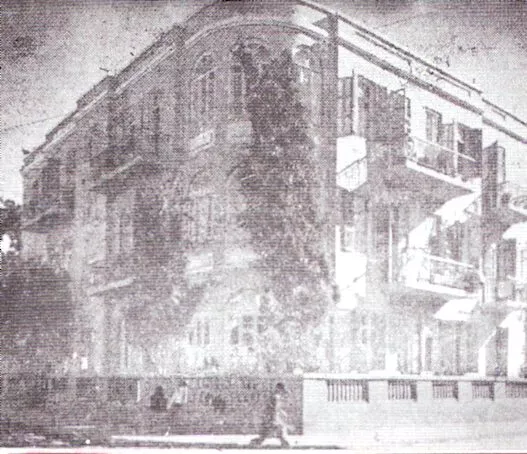
Lilienblum 16
Before you are word of remembrance by Nissan son of Michel Shoiean-Lev-Tov, from Vizhnitz-Haifa. (Courtesy of the Bukovina Jewry website)
~~~~~~
At the gathering of the students of the Dameshek Eliezer in 5756 (1996), I was asked, since I was born in Vizhnitz and was a student of the yeshiva there, to write about a subject that has not been written about until now, and this is the character and the ways of our Rebbe, the Dameshek Eliezer z”l, as the rabbi of the city of Vizhnitz, from his appointment on Purim 5682 (1922) until the end of 5695 (1935), when I emigrated to the Holy Land.
Therefore, this article contains and encompasses the years that I was in Vizhnitz. In order for the things to be immortalized and not forgotten, I consider it for myself to be a sacred duty and a pleasant one, to write them, and I pray that the L-rd will help me to fulfill this task faithfully and efficiently to the best of my ability.
Our rabbi’s blessed and extensive activities spanned various levels, such as:
A. Fulfilling his duties as the rabbi of the city, a father who takes care of his sons spiritually and physically.
B. Founding and managing of the “Beit Yisrael and Dameshek Eliezer” yeshiva
C. Guarding the walls of Judaism, which began in Vizhnitz and from there its blessed influence reached many of the country’s districts and in particular the area of Bukovina.
Here we will refer to the fulfillment of his role as the rabbi of the city and his guarding of the walls fo Judaism.
A Rabbi and Father
I remember when I was a child, that on Purim 5682 (1922) I heard from visitors to our home: “Today we have a double Purim, one like in the whole world, and another happy Purim because Rabbi Eliezer’ki became the rabbi of the city.” And they drank a l’chaim (cheers) in honour of this happy occasion.
And indeed immediately, our rabbi stood out not only as the rabbi of the city, but as a father and patron dedicated in heart and soul to all the residents of the city and its surroundings, as far as Seltin in the north and Mohilev in the south.
And I remember from the conversations of my parents and the members of the household, already at the beginning of his position as rabbi, that there was a case of an aguna (a woman who does not know the whereabous of her husband) in Vizhnitz as her husband had been taken prisoner in the First World War, and his fate was unknown for years.
And our Rebbe in his mercy answered her: I pray for you to G-d and hope that your husband will return, and wait out of prayer and hope to God. And then one day the man returned from his captivity to the joy of his wife and all of the people of the city. Thus his prayer was accepted and our Rebbe’s hope was fulfilled.
And to add to the story: immediately upon the return of the man who was a carpenter by trade, our rabbi ordered cabinets from him for his holy books, so he also made his heart happy when he was immediately able to make a living.
With the arrival of our rabbi to the city, he quickly took care of repairing and perfecting the mikvah, as a means of fortifying the pratice of family purity in the city, and in the same way he repaired the eiruvs (fences enabling Jews to carry on Shabbat).
During the First World War, many houses in Vizhnitz were destroyed, and some were also damaged, so one of our Rebbe’s first actions was to establish relations with the Joint in Europe and America, which would help rebuild the ruins and restore the city’s houses, by means of large financial grants and long-term loans. These were given to the Jewish residents of the city, who were about 95% of the total population.
Under his influence, he helped to rehabilitate needy and poor families, and to a certain extent also to establish them financially, in accordance with the spirit of love for one’s fellow Jew which he cherished in his heart as a scion of the glorious dynasty of Vizhnitz…
After that, he worked to renovate as much as possible the Great Synagogue – “Di Groise Shul”, which was badly damaged in the First World War, and covered it with a huge, new roof with a very high pole on top of it so that it would be higher than all the buildings in the city. He also built another small synagogue inside the building – A small Polish synagogue, and in this synagogue they sanctified the new moon with the majority of the people and with joy!
And perhaps this is the place to add a “memorial plaque” for the study halls in the city of Vizhnitz, which were destroyed, burned, and looted by the Russians, Romanians, and Germans, may their names be blotted out (Vizhnitz, as a border town, suffered terrible blows and destruction).
- The great study hall of our Rebbe (that was built in the time of the Tzemach Tzadik rabbi).
- The “Viznitzer Kloiz” study hall, in which prayers and Torah lectures were held from daybreak to nightfall.
- “Reb Leibel’s” study hall, named after one of the rabbis of the city in the time of the Tzemach Tzadik, where elderly people sat and learned for most of the day.
- “Itchi Frankel’s” study hall, built by Yitzchak (Itchi) Frankel z”l.
- “Fahedersht” (front) study hall.
- “Interesht” (back) study hall.
- “Nei Vizhnitz” study hall (known as Neivelt)
- “Chevra Tehilim” study hall
- “Polish” study hall inside of the Great Synagogue
- “Veizneka” study hall, nicknamed “Nofesh” (vacation/recreation)
“For these do I weep, my eye, my eye sheds tears” (Lamentations 1:16)
He also placed a fence around the old cemetery in the center of the city, to save it from desecration caused by it being turned into a cattle pasture in the absence of the fence.
Our Rebbe z”l bought a most luxurious building in Vizhnits, one of the most luxurious in the country, to serve as a dormitory for the students of the yeshiva, about which we will discuss more in a separate piece, G-d willing.
As well, our Rebbe bought a magnificent building for the Talmud Torah school, and brought an expert teacher from Grosswardein, and thus the Talmud Torah reached its glory.
The old Talmud Torah building which including the “Hachnasat Orchim” (hosting guests) house for the poor, our Rebbe z”l, watched over greatly, continuously and firmly.
For the Kashrut in the city, he appointed a permanent inspector of all the butchers. It should be noted that the butchers obeyed his discipline out of respect.
When the global Bais Yaakov movement was founded, by Sarah Schenirer z”l, he also founded a Bais Yaakov school for the girls of the city, and under his influence Bais Yaakov schools were also founded in other cities in Bukovina and Romania, and these schools educated the Jewish girls in a glorious way so that they could then go and teach others. In order to operate the schools, he brought teachers from the Bais Yaakov seminary abroad, under the auspices of Dr. Deutschlander z”l.
A special event of the time was the festive closing of the first year of Bais Yaakov in the city, with the active participation of our Rebbe, who with his noble appearance and his fiery speech, left a deep and indelible impression on the hundreds of participants, men and women. His speech instilled in them the vital importance of Bais Yaakov, and this festive occasion was a powerful motive and an example for other cities where there were Bais Yaakov schools.
Our Rebbe agreed to house the Agudath Israel youth group in the new Talmud Torah building.
(…)
Our rabbi’s daily routine began at 4:00-4:30 in the morning, upon sitting to study Gemara, the Rashi and Tosfot commentaries, and writing Torah thoughts. He also answered public questions addressed to him from all over the country, and this was despite his weak health. During the summer months, he sat during these early hours by the entrance to his apartment (which was like a balcony) and studied and wrote as above.
It is also known about his correspondence in responsum with the great men and geniuses of the Jewish People at the time.
When he came to settle in the Holy Land, in 5704 (1944), he mentioned many times with deep pain the loss of his writings, which he wrote for nearly thirty years and which were lost in the Holocaust.
A significant part of his time was occupied with Torah laws, in which he shared with the city dayan (religious judge) Rabbi David Schneibelg z”l. The Torah laws he dealt with were related to all levels of the city’s population: between spouses, between neighbours, between merchants, between homeowners and their tenants, between heirs, etc. Our Rebbe also tried very hard to promote peace and reconciliation between the litigants when they left the court sessions. Some of the cases were of trespassing, not out of malice, but due to the burning and destruction of the buildings during the war, they did not know exactly where the borders were. For this purpose, our Rebbe used to go out in such cases to the place in question, to see the place with his own eyes, and he called this “Oigen Schein” (beautiful eyes).
He went to these places on Fridays, on his way to dip in the mikva (ritual bath) in honour of the holy Shabbat. The rulings that he and the aforementioned dayan made were based on the depths of halacha (Jewish law), wisdom, reason, and resourcefulness, and were recorded by the dayan in the register of rulings.
The dayan z”l also gave Gemara, Rashi, and Tosfot lessons to the students of the yeshiva, and every day he taught them the Yoreh Deah and Choshen Mishpat works in the morning and evening. It is worth noting here that the dayan z”l would always answer when he was approached, with questions about kashrut, Shabbat, and more. In addition, the dayan would teach the daf yomi (daily page of Talmud story) five times a week at the “Vizhnitzer Kloiz”, in front of a large audience. On Shabbat, he taught Ethics of the Fathers there in front of a large audience, and while studying, he inspired the audience to godliness, morality, educating children in the way of the Torah, and the mitzvahs between a person and his fellow.
The dayan also represented our Rebbe with respect and a noble appearance (as the Rebbe was sometimes prevented from traveling due to his poor health or because of public issues) in state institutions and before ministers and officials of the state, in order to thwart decrees against the observance of Shabbat, and he was very successful in his tasks. He also spoke and greeted the king at national events of the Romanian government, such as: the birthdays of the king, independence days, etc., When gatherings for students and teachers were held, both for Jews and gentiles, they took place in the Vizhnitzer Kloiz (because 95% of the students were Jewish).
In the summer months, when our Rebbe z”l stayed in Carlsbad for his health and for a vacation, the responsibility of the yeshiva and its students rested on the dayan, and he fulfilled his purpose with devotion and love for the students.
As we already have written, there were ten synagogues in Vizhnits in which Torah classes were constantly held. In those where there were no lessons yet, our Rebbe led “Torah lessons” in the morning and evening, and for this purpose he sent selected yeshiva students to teach the lessons to the men.
Guarding Shabbat
With all the warmth of his soul, our Rebbe prayed that Shabbat would be observed in the city carefully, by the entire Jewish population. To this end, he appealed to the merchants who had business in Czernowitz, not to go there on Friday for commercial matters, so that they would not have to return on Friday afternoon, and this is because when there was a snowstorm that covered the railroad tracks, and the snow froze on the tracks, the train remained stationary in the open fields. In places where there was no settlement, the merchants were forced to reach Vizhnitz on Friday night.
Thanks to his personal appeal to the merchants, almost everyone stopped traveling on the Friday afternoon train from Czernowitz to Vizhnitz. When he learned that there were still individuals who did not stop traveling as above, he walked on Friday night, a long walk from his house, to the train in the bitter cold, accompanied by a student or a gabbai (assistant), And blessed those who came home with “gut Shabbes, gut Shabbes, gut Shabbes!” (Have a good Shabbat) And of course in the end they also stopped traveling!
He also ordered the manager of the bathhouse and sauna to close them on Friday 45 minutes before Shabbat, so that the bathers would arrive home before Shabbat. He would also go out on Shabbat evening to the hair salons, enter, and ask to hurry up and finish, to prevent barbers and customers from desecrating Shabbat at the hair salons.
Like other rabbis, our Rebbe gave a speech on Shabbat HaGadol (the Shabbat before Passover) and Shabbat Teshuva (the Shabbat between Rosh Hashana and Yom Kippur); on Shabbat Teshuvah he listed those who are exempt from fasting due to their health, and the food amounts for those who fast but are allowed to eat small portions. In the Shabbat HaGadol sermon, he listed the types of leaven that are not known to the public, such as: perfume and perfume water made from grains, certain ointments, etc.
In addition to this, he would also call for urgent meetings if there were any breaches in commandments, and the audience would respond and come in droves and listen to his words.
A selected extract from his sermons, which were full of words of Torah and wisdom, and whose contents tugged at hearts, is preserved by memory and will be published, G-d willing.
When the artisans of the city gathered to found the “Association of Artisans” (Hand-Worker Freien), our Rebbe was invited to honour the event with his presence and accepted their invitation. When he was asked to give his blessing to the aforementioned foundation, he congratulated them on their success, and in his speech raised their spirits by stating that they were equal with those in the liberal professions. He said, among other things:
“Blessed is everyone who fears G-d, who walks in His ways, if you eat the fruit of your hands your hands etc. These two things – fear of G-d and eating the fruit of your hands, are the basis of life in the way of the Torah.”
Later in his words, he said: You will certainly have “statutin” (regulations) on who is worthy to be a member of this association, but there are already “statutin” that were “made” by the Almighty Himself, and King David in Psalms 15 details them: “Who will dwell in your house , one who walks innocently and acts righteously and speaks the truth in his heart… he does not do evil to his neighbor and the fearer of G-d will be honored… he who does these things will never be turned away.”
And he also said: “Great is a work that honors its owner (Nedarim 22), and greater is work than merits of the forefathers (Bereishit Rabba).” He then mentioned as an example ten of the Tanaim and Amoraim (Mishnaic and Talmudic era rabbis) that worked to make a living. They were: Hillel the elder was a woodcutter (Yoma 15), Shamai was a builder (Shabbat 31), Rabbi Yossi ben Chalafta was a leather worker (Shabbat 39 ), Rabbi Yehoshua who was chosen as Nasi (a Jewish leader) was a blacksmith (Brachot 28), Rabbi Nachunia was a shrub digger (Shkalim 28), Rabbi Chanina and Rabbi Ushaya were shoemakers (Pesachim 23), Rabbi Yochanan was a shoemaker (Avot 84), Rabbi Yitzchak Nafacha was a metal worker (Chulin 100), Rabbi Ada HaBolaah was a paid cattle herder (Bava Metzia 43), and Rabbi Yehuda was a sealer (Bava Batra 133).
And he finished: Both those who are professions and those whoare artisans must respect their friends and respect each other, and there should be no jealousy, hatred, nor competition between them, which destroy the life of a person and his family. We must know that G-d’s blessing enriches (Proverbs). He also reminded them of the prohibition of shatnez (mixing wool and linen), and their obligation to do their work honestly, and not to work late on Friday afternoons.
A sense of satisfaction was visible on the faces of all the listeners, and at the end of his speech they all went to thank him. He shook the hand of each one and blessed them, and there was a great santification of G-d’s name.
Assisting the Poor
Every winter he ensured the supply of firewood to those in need, and therefore he organized businessmen to take care of the matter and helped them obtain the funds. He did this in the spirit of what is said in Tractate Gitin 19: “And praised be those who take care of wood.”
With a rare and wonderous self-sacrifice, he dedicated himself to “kimcha depischa” (collecting at Passover time for the needy) for the poor of the city. Despite his weakness and poor health, he started visiting the city’s residents immediately after Purim to collect for “kimcha depischa”. Even stormy and extremely cold weather and snowy roads, on which there was barely a path for walking, did not prevent him from this holy and important mitzva, which he performed day in and day out, many hours each day. Due to his dedication and perserverance in the important task, he was able to collect considerable sums and distributed them to the needy, who were the able to prepare their needs for the holiday. He warmly blessed all the donors with a “Kosher and Happy Passover”.
Throughout the year, he also took care of the sick and homebound, the elderly and the disabled, and sent them young men from the yeshiva (in shifts), to spend the night with them and feed them. He also greatly helped the represents and private individuals who came to collect donations for various purposes, such as helping families blessed with children, assisting brides, and more.
Since Vizhnitz was a border town between Poland and Bukovina (the Czermosz River was the separation), Jews crossed the border for help and assistance. The official transit certificate, the “Peshefiska” to stay in the place was given for 5 days only. It goes without saying that the duration of this stay was not enough for collecting money, and they had to stay in Bukovina for many weeks. Thus, they had to return to Poland later by difficult and illegal routes. For this purpose, the Rebbe paid large sums to “professional smugglers”, who carried the people across the river on their shoulders at night. This action was dangerous for him as well if he had been caught, but even in this, as in all his days, he would take risks in order to help others.
~~~~~~
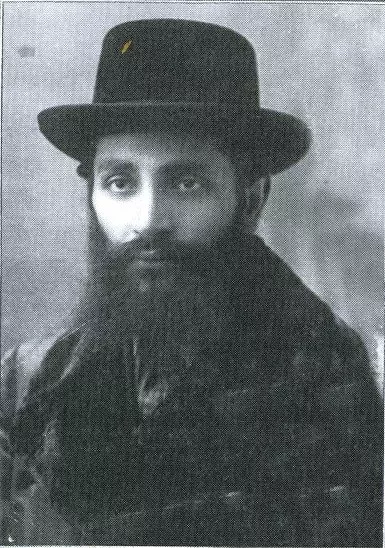
In light of all of the above, we can conclude with what we started with, that indeed, our Rebbe, at the same time as being the rabbi of the city of Vizhnitz, was also a faithful and devoted father to the city. He conducted his leadership in both a levelheaded and pleasant way, and frequently combined the concern for all the Jews of the city and its surroundings spiritually and physically, and he did everything with a lit up face, with nobility, and with great love for each and every individual.
But there is even more to research on the matter… (Courtesy of the Bukovina Jewry website)
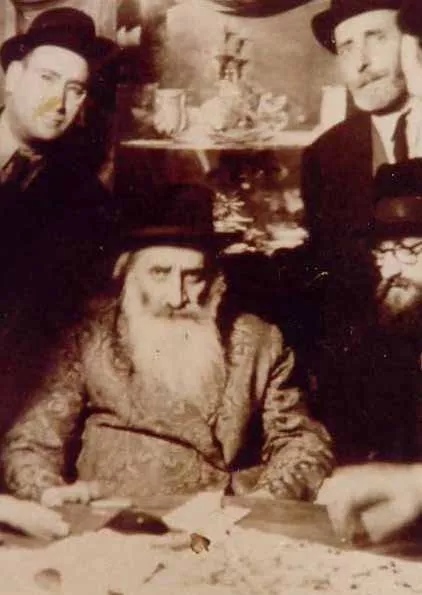
In Timișoara (Temisvar)
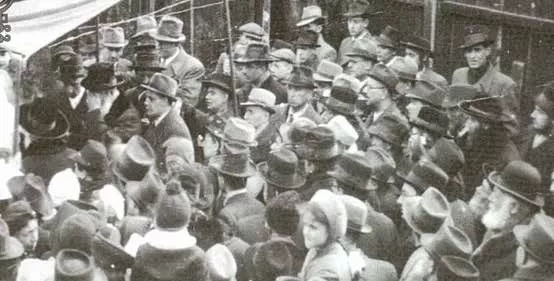
A wedding ceremony in Timișoara
[1] According to a version I heard from an informed person among the Vizhnitz chasidim, the gold watch was sold to save his pious sister, Rebbetzin Henia Friedman of Boyan Czernowitz, who tragically drowned on her escape voyage on the Mefkure ship. About her fate and that of the Boyaner Rebbe and the ship in general, will be elaborated upon in a separate article, G-d willing.












